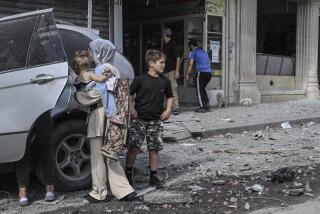PERSPECTIVE ON HIROSHIMA : Targeting of Civilians Is Now the Ugly Norm : Mass bombing was made possible by technology, which still dictates policies of callous disregard for human life.
- Share via
B lood and destruction shall be so in use,
And dreadful objects so familiar
For the record:
12:00 a.m. Aug. 11, 1995 For the Record
Los Angeles Times Friday August 11, 1995 Home Edition Metro Part B Page 9 Op Ed Desk 1 inches; 24 words Type of Material: Correction
Wrong picture: An article Aug. 4 on the targeting of civilians during wars carried an incorrect picture. The author, Roger N. Johnson, of Ramapo College, N.J., is shown here.
PHOTO: (Roger N. Johnson)
That mothers shall but smile when they behold
Their infants quartered with the hands of war. -- “Julius Caesar,” Act 3
William Shakespeare The bombing of the Federal Building in Oklahoma City brought home to Americans the horror and suffering that can be caused by a single bomb detonated in the middle of a city. Magnify the Oklahoma City devastation by 25,000 times and one has the equivalent of one Hiroshima bomb. Imagine a freight train 300 miles long loaded with Oklahoma City bombs. That’s the equivalent of one modern nuclear warhead, just one of tens of thousands poised all over the world.
The policy of destroying cities with bombs deserves some reflection as we mark the 50th anniversary of the most destructive bombing that the world has ever known. The firebomb raids on Dresden in February, 1945, and Tokyo the following month killed at least as many as the atomic bombs that incinerated Hiroshima and Nagasaki. From May to August, 1945, the United States dropped 158,000 tons of bombs on Japan, roughly the equivalent of 300,000 Oklahoma City explosions.
The deliberate killing of civilians is a relatively new practice in the conduct of war. World War II was the first major war in which the majority of the victims were civilians; today, civilian casualties vastly outnumber military deaths in Bosnia, as they did in Chechnya. Paradoxically, as the efficiency of killing civilians has increased, the moral outrage has decreased.
There is a long and mostly forgotten history to the problem of what the Pentagon euphemistically calls “collateral damage.” In the 4th Century, St. Augustine wrote in “The City of God” that peace may require violence against evildoers, but warriors should kill only with anguish and regret. This “just war” doctrine became elaborated over the ages in the Christian world, but it always held that the deliberate killing of civilian noncombatants must be forbidden. Today, the targeting of civilians is routine. How did this dramatic change in morality come about?
On April 26, 1936, Nazi planes flew over Guernica, Spain, and dropped primitive explosives on residential areas. This act drew immediate public outrage all over the world and inspired the painting that has become a classic anti-war statement: Picasso’s monumental “Guernica.” The following year, Italian pilots did the same thing to Barcelona. There was widespread sentiment at the time that pilots who kill innocent civilians should be tried as war criminals.
On Nov. 14, 1940, the Luftwaffe bombed Coventry, killing 554, mostly civilians, and the Germans coined the word Coventrisieren (to raze to the ground). Outraged, the Royal Air Force retaliated a month later by destroying the city of Mannheim. And so it began.
The master of such planning was Sir Arthur Harris, commander of the Royal Bomber Command. In July, 1943, he monitored the weather patterns over Hamburg until they were just right for creating a firestorm. When conditions were optimal, his bombers dropped thousands of 4-pound phosphorus explosives designed to set roofs on fire. As planned, a catastrophic firestorm of hurricane proportions engulfed the city and killed at least 30,000; 20% of the victims were children.
“Bomber Harris” remains a hero to many, and in 1992 the British erected a monument in his honor. Others remember him as “Butcher Harris.”
As the war in Europe was drawing to a close, hundreds of thousands of refugees fled from the Russians toward the undefended German city of Dresden. This historic and cultural treasure was of little military significance and one of the few German cities unscathed by war. The British and Americans, concerned about Stalin’s postwar ambitions, decided to impress him with a show of military ruthlessness.
On the night of Feb. 13, 1945, the RAF dispatched a wave of 245 bombers that carpeted the medieval city of densely packed wooden roofs with hundreds of thousands of incendiary fire sticks. A few hours later, a second wave of 550 bombers was sent in to magnify the blaze. The next day, the city was attacked a third time by 450 B-17 Flying Fortresses from the U.S. 8th Air Force.
Official estimates of casualties have ranged from 30,000 to 250,000. Some military analysts called Dresden one of the major atrocities of the war. Others shrugged it off and argued that civilians could no longer be immune in airborne war. As one American navigator who took part recalled, “It was just a normal type of raid.”
In spite of the terrible destruction in Europe, the technique of saturation bombing was still in its infancy. With the larger and faster B-29 Stratofortresses deployed over Japan, the U.S. Air Force turned carpet bombing and firebombing into a science. In the closing months of the war, 75% of the munitions dropped on Japan were incendiary bombs designed to ignite wooden homes. The firebombing of Tokyo in March, 1945, destroyed 267,171 structures and left 1 million homeless. The killing of civilians by the hundreds of thousands was now commonplace, which made the decision to drop the atomic bomb even easier.
Technology marches on. In the Vietnam War, carpet bombing techniques were made even more deadly with the greater payloads of the B-52. More bombs were dropped in Vietnam than in all theaters of World War II combined. Unexploded cluster bombs and anti-personnel munitions continue to kill and maim civilians, 40% of them children.
In the Persian Gulf War, the public was led to believe that most of the allied air attacks involved “smart” bombs with pinpoint accuracy aimed at military targets. After the war, we learned that the vast majority of the ordnance consisted of old-fashioned “dumb” bombs that often missed their targets. The Pentagon insisted that it was not targeting civilians, yet it deliberately destroyed water supplies, knowing full well that the suffering would be borne mainly by women, children and the elderly. American public health officials estimated that more than 100,000 Iraqi children died from war-related causes.
In the British War Museum, a special clock tallies the number of human beings who have died from wars in the 20th Century. The toll is fast approaching 100 million, 12 times higher than that of the 19th Century and 22 times greater than the 18th Century’s. At this rate, we might expect 1 billion people to die in the wars of the 21st Century; military analysts believe that a nuclear war could easily generate 500 million casualties.
Where is the outrage? Are our national priorities of the future going to be as militaristic as the past? Fifty years after the war that made targeting civilian populations an acceptable military strategy, bomber pilots are heroes and the search for more terrible weapons continues. The current conservative Congress censors a Smithsonian exhibit critical of the suffering wrought at Hiroshima, slashes funding for education, the environment, health and the arts, and votes huge expenditures for more long-range nuclear attack B-2 bombers. The American public appears to be supportive, since 3.9 trillion taxpayer dollars have been sunk into nuclear weapons programs alone since 1945. By this measure, all the ingredients are in place to guarantee that the future will be worse than the past.
More to Read
Sign up for Essential California
The most important California stories and recommendations in your inbox every morning.
You may occasionally receive promotional content from the Los Angeles Times.










